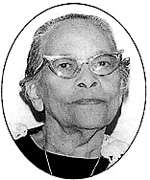Mabel Keaton Staupers
| Mabel Keaton Staupers | |
|---|---|
 | |
| Born |
February 27, 1890 Barbados |
| Died | November 29, 1989 (aged 99) |
| Fields | Nursing |
| Alma mater | Freedmen's Hospital School of Nursing |
| Known for | Nursing administration |
| Notable awards |
Spingarn Medal 1951 American Nurses Association Hall of Fame 1996 |
Mabel Keaton Staupers (February 27, 1890 – November 29, 1989) was a pioneer in the American nursing profession. Faced with racial discrimination after graduating from nursing school, Staupers became an advocate for racial equality in the nursing profession.[1]
Biography
Staupers was born on February 27, 1890, in Barbados, West Indies.[2] In 1903, at the age of thirteen, she emigrated to the United States with her parents, Pauline and Thomas Doyle. She attended Freedmen's Hospital School of Nursing in Washington, DC, where she graduated with honors. After graduation, she worked as a private duty nurse.
Staupers fought for the inclusion of black nurses in World War II to the Army and Navy as the executive secretary of the National Association of Colored Graduate Nurses (NAGCN). She wrote that "Negro nurses recognize that service to their country is a responsibility of citizenship."[3]
She continued fighting for the full inclusion of nurses of all races in the US military, which was granted in January 1945. In 1948, the American Nursing Association followed suit and allowed African-American nurses to become members. In 1950, Staupers dissolved the NAGCN because she believed the organization had completed its mission. In 1951, the NAACP honored Stauper with the Spingarn Medal in recognition of her efforts on behalf of black women workers.[4]
During World War II, Staupers assembled support and fought to stop the usage of quotas in the military.[5] Quotas were used in the military to restrict the number of black nurses the military hired.[5]
While working as a private nurse in Washington and New York, Staupers helped establish the Booker T. Washington Sanatorium.[5] It was one of the few clinics founded to care for African Americans who had tuberculosis,[5] at a time when other hospitals refused black medical experts privileges or staffing positions.[5] Staupers served as Superintendent for the Booker T. Washington Sanatorium from 1920 to 1922.[5] Staupers used her influence and management skills and became executive secretary of the Harlem Committee of the New York Tuberculosis and Health Association,[5] a position she held for twelve years. In December 1935, Staupers attended a gathering of African American women leaders, organized by Mary McLeod Bethune and intended to establish the National Council of Negro Women.[5]
References
- ↑ Carnegie, Mary Elizabeth, The Path We Tread: Blacks in Nursing, 1854-1990, National League of Nursing Press, 1991, p. 95.
- ↑ Hine, Darlene Clark (1994). "Staupers, Mabel Keaton (1890–1989)". Black Women in America: An Historical Encyclopedia. Bloomington: Indiana University Press. pp. 1106–1108. ISBN 0-253-32774-1.
- ↑ Hine, Darlene Clark, Black Women in White: Nursing Conflict and Cooperation in the Nursing Profession, 1890 to 1950, Indiana University Press, 1989, p. 174.
- ↑ Biondi, Martha (2009). To Stand and Fight: The Struggle for Civil Rights in Postwar New York City. Cambridge, MA: Harvard University Press. p. 14. ISBN 0674010604.
- 1 2 3 4 5 6 7 8 Hine, C. D., Hine, C. W., Harrold, S. (2011), The African-American Odyssey. Upper Saddle River, N J.: Pearson.
External links
- American Nurses Association 1996 Hall of Fame Inductee: Mabel Keaton Staupers
- African American Registry: Mabel Staupers was a nursing pioneer
- "Mabel Staupers, 99, Leader for Nurses, Dies", New York Times, October 6, 1989.
| Library resources about African American Nurses |